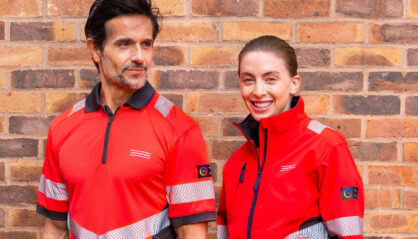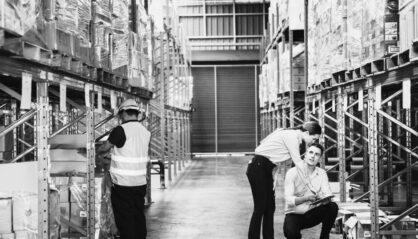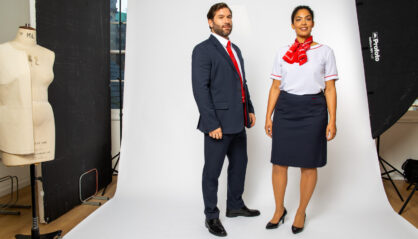Why Your Company Needs Winter Workwear

As the chill of winter approaches, it’s important to consider the impact of the cold weather on the comfort, safety and performance levels of your staff.
Making sure your employees are kept warm and comfortable during their working hours can help maintain a high level of morale and productivity, and ensure that each member of your team is able to carry out their responsibilities safely.
However, winter weather in the UK is known for its unpredictability, which makes it important that your custom work uniform is not only warm and comfortable, but also versatile and adaptable enough to handle the ever-changing temperatures.
In the mission to strike a balance between adaptability, warmth, and comfort, it’s also important not to overlook the need for a work uniform that communicates a professional brand image.
A considerable amount of thought and planning needs to go into designing truly effective winter workwear that meets all these important criteria.
In this article, we will explore in greater detail how colder weather can affect employee health, motivation and performance, and how thoughtfully designed winter workwear is an important consideration for any business.
Understanding the physical and psychological effects of cold on employees
From an employee wellbeing perspective, the effects of cold weather on the body shouldn’t be underestimated – especially for workers who spend prolonged periods of time outdoors.
When your body becomes cold, it restricts blood flow to your skin and extremities like your hands and feet, in an attempt to try and retain a stable core body temperature.
This reduced blood flow to the extremities can lead to an increased risk of conditions like frostbite, and sustained exposure to cold temperatures can also increase the risk of hypothermia, which occurs when your body temperature drops below 35 degrees.
Not all physical symptoms of the cold are immediately visible. For example, cold temperatures can also trigger an involuntary response known as vasoconstriction which causes blood vessels to narrow.
This condition can actually increase your blood pressure and increase the strain on your heart, which for some people can have serious implications. A study conducted by the British Heart Foundation found that the colder the weather, the higher the average cholesterol and blood pressure, which can increase the likelihood of heart related issues.
The cold weather also has an impact on employees from a psychological perspective, affecting mood and mental alertness and often leading to decreased cognitive performance and reduced focus.
A study from Cornell University looked at the error rate of a typing task at different temperatures. At the comfortable temperature, the typing error rate was 10%. At colder temperatures, this error rate increased to 25%.
In the context of employees in the workplace, it’s clear to see how the reduced focus and alertness from the cold weather can potentially reduce your team’s ability to perform their daily tasks.
How does the cold impact employee motivation and performance?
The cold weather’s impact on employees extends beyond their physical and mental well-being, and can also influence their work performance.
When the weather is cold, the body needs to use more energy to keep warm, which can lead to increased fatigue among employees. This fatigue can affect their motivation and proactivity at work.
Studies have shown that the ideal temperature for peak productivity is between 20 and 24 degrees. Within this range, employees tend to be optimally positive and productive. However, in colder conditions, there’s a noticeable dip in motivation, energy levels, and willingness to take on challenging tasks.
Fortunately, by providing well-designed staff workwear that is suitable for colder temperatures, businesses can help their employees stay warm, comfortable, and productive – whatever the weather.
Designing custom uniforms for colder weather
Effective winter workwear requires intelligent design that combines warmth, functionality, and adaptability to various conditions.
At the same time, the design process needs to ensure uniforms are functional and safe for employees, whilst allowing them to easily adjust layers to control their own temperature.
Tailoring uniforms for different job roles and industries
When it comes to winter workwear design, it’s important to make sure your uniforms are suitable for the specific needs of different job roles within your business.
For example, outdoor workers are likely to require outerwear made from weatherproof materials that can withstand conditions like rain, sleet and snow. Indoor workers might benefit more from layered uniforms made from lighter materials that still provide warmth but offer greater flexibility. And employees that have a hybrid outdoor/indoor role are likely to benefit from a combination of both approaches.
JSD’s work with South Western Railways is a great example of designing effective winter workwear for a range of job roles.
JSD were commissioned to design a new uniform for the business during a period of change for SWR. It was more than just a uniform update – it was a project that needed to engage and motivate staff, create a sense of renewed identity, and ensure that all employees were able to complete their daily duties with a sense of comfort and professionalism.
The challenge was in creating staff workwear that was suitable for a wide range of job roles, ranging from drivers and on-train staff to platform staff and cleaning crews.
JSD’s design approach involved extensive on-the-job research, focus groups, and consultations with both unions and staff. The result was a distinctive uniform that met SWR’s branding and business goals, and ensured that the comfort and functional needs of all employees were met in a wide range of weather conditions.
Layering: for employee empowerment, insulation and heat retention.
Layering is an important principle in custom winter uniform design, as it helps empower staff and improves the insulation and heat retention of your uniforms.
With well designed layering, employees can add or remove uniform items based on fluctuating temperatures, whilst maintaining a professional image.
For example, if the day starts off at sub-zero temperatures, members of your team might choose to ‘layer up’ with all uniform items. Should the afternoon get warmer with some bright winter sun, your employees have the ability to remove certain items to make sure they are working at a comfortable temperature.
Each layer of your uniform can be designed to provide a specific function. When these layers are strategically combined, they can work together to create an insulating effect, effectively trapping warmth and improving employee comfort.
For example, the base layer of your uniform might be made from moisture-wicking material to help keep your employee’s skin dry. The middle layer of your custom might act as the main insulator, made from materials which trap heat effectively but also accommodate breathability. The outer layer might be windproof and waterproof to protect against the elements.
Choosing the right materials for each layer of your winter uniforms is important to ensure the comfort of employees working in cold conditions.
It requires a lot of thoughtful planning, as different materials all have their own unique properties. For example, when considering the mid-layer of a winter uniform, fleece material is lightweight which is ideal for active roles, whereas merino wool might offer superior breathability, warmth and comfort. And when you’re looking at weatherproof materials for the outer layer of winter workwear, it’s important to consider the balance between durability, water resistance and breathability.
Every business and job role is unique, and the choice of materials used in your custom uniform is going to vary based on your specific business needs.
At JSD we have a tailored, bespoke work uniform design process that starts by getting a thorough understanding of your business and the needs of each of your employees, before coming up with uniform concepts to keep your team warm, safe, comfortable and productive throughout the seasons.
JSD: Bespoke, sustainable workwear for every season
The design of your winter workwear can have a significant influence on the comfort, safety, productivity and performance of your employees during the colder months of the year.
At JSD we’ve been designing year-round workwear for international brands since 1981, and we have expertise in creating bespoke sustainable uniforms that perfectly align with your business needs and the job roles of each individual employee.
If you’re looking for a more thoughtful approach to your winter workwear design, get in touch with [email protected].





